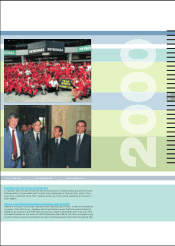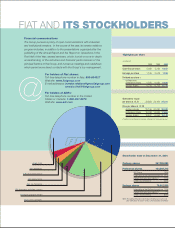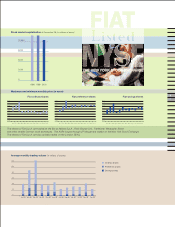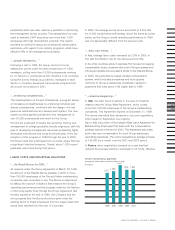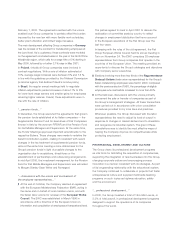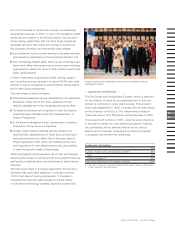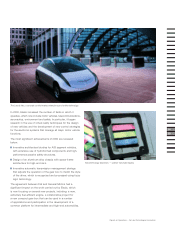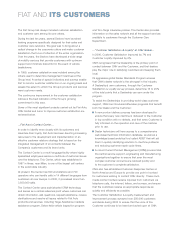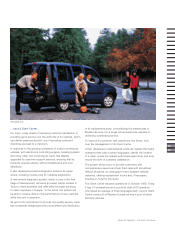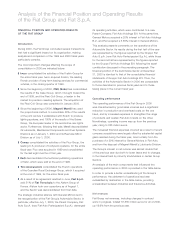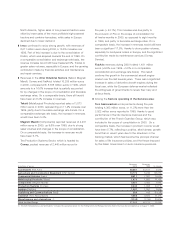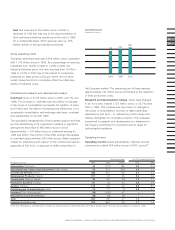Chrysler 2000 Annual Report Download - page 29
Download and view the complete annual report
Please find page 29 of the 2000 Chrysler annual report below. You can navigate through the pages in the report by either clicking on the pages listed below, or by using the keyword search tool below to find specific information within the annual report.
The ability to innovate enables the Fiat Group to increase
the competitiveness of its Sectors and creates value for its
customers by improving performance, shortening production
times, reducing costs and enhancing quality. Research plays
a key role in the Group’s strategies and growth programs and
is carried out through highly innovative transversal projects
developed by the Fiat Research Center (FRC) and Elasis.
Overall, more than 13,000 people in 131 centers in Italy
and abroad worked on the Group’s research and development
projects in 2000, with total expenditures of 1,725 million euros,
equivalent to over 3% of revenues of the industrial activities.
Fiat Research Center
With its wealth of sophisticated equipment, its staff of more
than 900 employees and a network of over 1,000 outside
researchers, the FRC is the largest private-sector research
organization in Italy. In 2000, the FRC transferred 110 new
products and processes and 156 new methodologies to
Group Sectors. In addition, it handled more than 300
consulting assignments, transferring technology to Group
suppliers and other small and medium-size businesses.
In recent years, in continued pursuit of a strategy of
internationalization, the FRC participated in a significant
number of programs sponsored by the European Union.
In 2000, the FRC was awarded 49 new projects that, when
added to those already in progress, make it the leading
developer of research initiatives under the Fifth Research
Framework Program in terms of the quality and number
of projects approved.
In Italy, the FRC submitted new financing applications for 16
projects, with a total cost of more than 80 million euros over
three years. In addition, it filed 53 new patent applications.
The major achievements of 2000 are reviewed below:
❚Seicento Elettra Fuel Cell. This is the first prototype of
an automobile where fuel cells are used to power an electric
motor and recharge the batteries. Developed with partial
financial support from the Ministry of the Environment and
Fiat Auto, it represents a first step towards the development
of a compact car powered with hydrogen fuel cells. With
this configuration, the driving range of the Seicento Elettra
increased by about 70% and the battery recharging time
was lowered to just ten minutes.
❚Concept Tripmate NEA. This concept car, which was
created for Fiat Auto, embodies all the FRC innovations in
intelligent transport systems, with particular emphasis on
preventive safety and the creation of an effective interface
with the outside environment and the driver through online
and computer-based applications. The extensive use of
innovative technologies makes this vehicle a true “trip mate.”
❚InfoDaily. Through effective use of online technology,
this vehicle, which was developed for Iveco, provides
an ergonomic and user-friendly interface that enables
occupants to access a wide range of services, including:
wireless telephone communications, traffic information,
roadside assistance, logistics management through vehicle
tracking and online navigation, and remote diagnostics.
❚Nanotechnologies. Working in cooperation with the
NanoWorld Project Corporation, the FRC is constructing a
lab for the molecular assembly of highly innovative materials
that can be used in optics, photonics and numerous
industrial applications. This collaborative relationship will
enable the FRC to develop a new process that will be used
to manufacture quickly and inexpensively new lighting
devices, man-machine-environment communication systems
and new materials for filters and sensors.
Elasis
Elasis was established with the objective of creating a
technical and scientific network in Southern Italy that could
support innovation at the manufacturing facilities of the Fiat
Group. It now employs 506 researchers and 486 operational
technicians.
FIAT AND TECHNOLOGICAL INNOVATION


